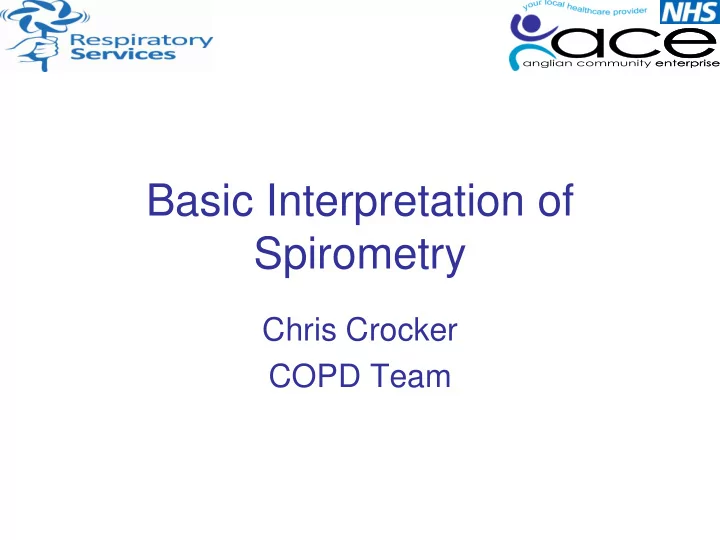

Basic Interpretation of Spirometry Chris Crocker COPD Team
Aims • When to do spirometry • When not to do spirometry • Definition of terms • Different patterns in spirometry • Problems • Interpreting Time/Volume graphs
Spirometry Spirometry is a method of assessing lung function by measuring the volume of air a patient can expel from the lungs after maximal inspiration
WHY WE DO IT ! • Diagnosis confirmation • COPD classification • Disease progression • Response to treatment • Health Promotion (Smoking Cessation) • Targets
FINDING THE MISSING MILLIONS National Clinical Strategy recommends “ A diagnosis of COPD should be confirmed by quality assured spirometry…..”
When not to perform spirometry • Inadequate training • Inadequate equipment • Lack of quality control • Contra-indications • During or immediately after an exacerbation
Contra-indications • Haemoptysis • Pneumothorax • Unstable cardiac status • Aneurysm • Recent eye surgery • Recent thoracic or abdominal surgery • Acute disorders: D&V, Exacerbations
How we do it! • Equipment / spirometers /syringes • Cleaning • Temperature • Calibration/Verification checks • Filters
Patient preparation • Pre-test information • Documentation • Patient comfort • Explanation/demonstration • Seated, chair with arms
Definition of terms • FEV 1 • FVC • VC (RVC,SVC,EVC) • Ratio FEV 1 /FVC or FEV 1 /VC
FEV 1 (Forced Expiratory Volume in 1 second) FEV 1 Time in seconds
FVC The maximum volume of air exhaled as rapidly, forcefully and completely from maximum inspiration FVC
Relaxed Vital Capacity The maximum volume of air expelled during a relaxed exhalation from maximum inspiration
FEV 1 % or Ratio of FEV 1 to FVC FEV 1 /FVC x 100 The proportion of air exhaled in one second This percentage is important in identifying airways obstruction
Airflow Obstruction Definition of airflow obstruction: FEV 1 <80% predicted and FEV 1 /FVC <70%
Definition of Chronic Obstructive Pulmonary Disease (COPD) COPD is predominantly caused by smoking and is characterised by airflow obstruction that is not fully reversible. The airflow obstruction does not change markedly over several months but is usually progressive in the long term. (NICE 2010)
COPD Classification NICE Guidelines • Mild COPD FEV ı 80% >predicted • Moderate COPD FEV ı 80-50% predicted • Severe COPD FEV ı 50-30% predicted • Very Severe COPD FEV ı <30% predicted
Different Patterns in Spirometry • Normal • Obstructed • Restricted • Combined/Mixed
Normal spirometry trace education for health
Restrictive Spirometry Restrictive : due to conditions in which the lung volume is reduced, eg fibrosing alveolitis, scoliosis. The FVC and FEV1 are reduced proportionately.
Reporting Spirometry • Results should be the greatest values achieved from 3 technically acceptable blows. (FEV 1 within 5%) • Poorly performed spirometry is worse than no spirometry!
QUALITY? National strategy cites an example: 31% of spirometry measurements in 38 practices in Rotherham met the required standard of 3 readings within 5% ( in contravention of BTS and GOLD spirometry standards)
New Guide to Spirometry!!! • A Guide to Performing Quality Assured Diagnostic Spirometry • www.pcc.cic.org.uk
Problems! • Slow start • Short Blow • Cough • Leaks around mouthpiece • Sub-maximal effort • Unable to achieve 3 acceptable results • Inadequate rest between attempts
Parameters of Lung Function Normal Obstructive Restrictive Combined FVC >80% Normal Reduced Reduced FEV 1 >80% Reduced Reduced Reduced FEV 1 / Normal/ >70% Reduced Reduced FVC High
Reading the tracing • Is the spirometry valid ? • Check sex/age/height/weight/BMI • Check tracing for problems • Identify ACTUAL ratio ? obstruction • Identify FEV1 and % predicted • Check VC and FVC ? Air trapping ? Reduced volumes • Remember to use largest measurement from valid blows, (these may not all be from one blow) • Do the figures fit with the tracing? • Interpret together with history, symptoms and medication
Training • Do not perform spirometry without training • ARTP (www.artp.org.uk) • EQUIP (www.essexequip.nhs.uk) • Education for health (www.educationfor health.org.uk)
Thank you for listening Any Questions ?
Recommend
More recommend